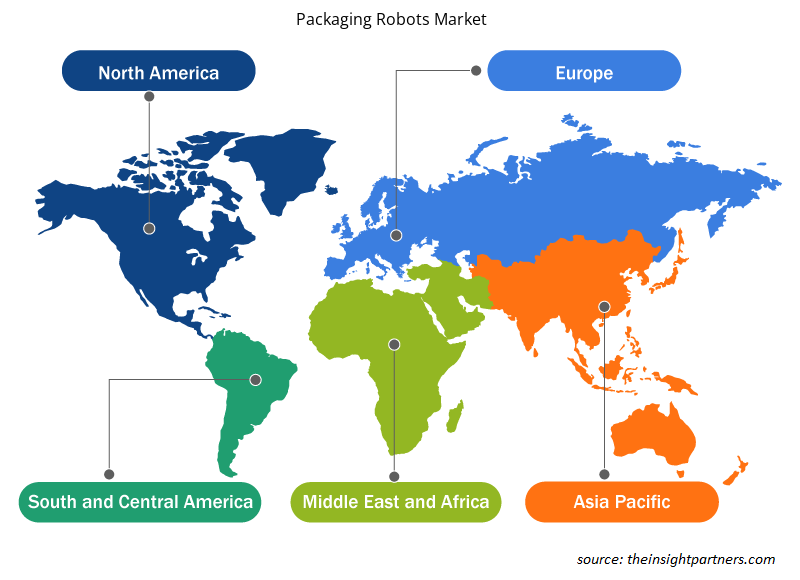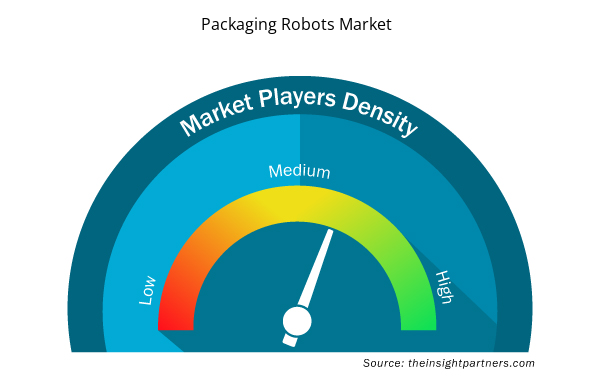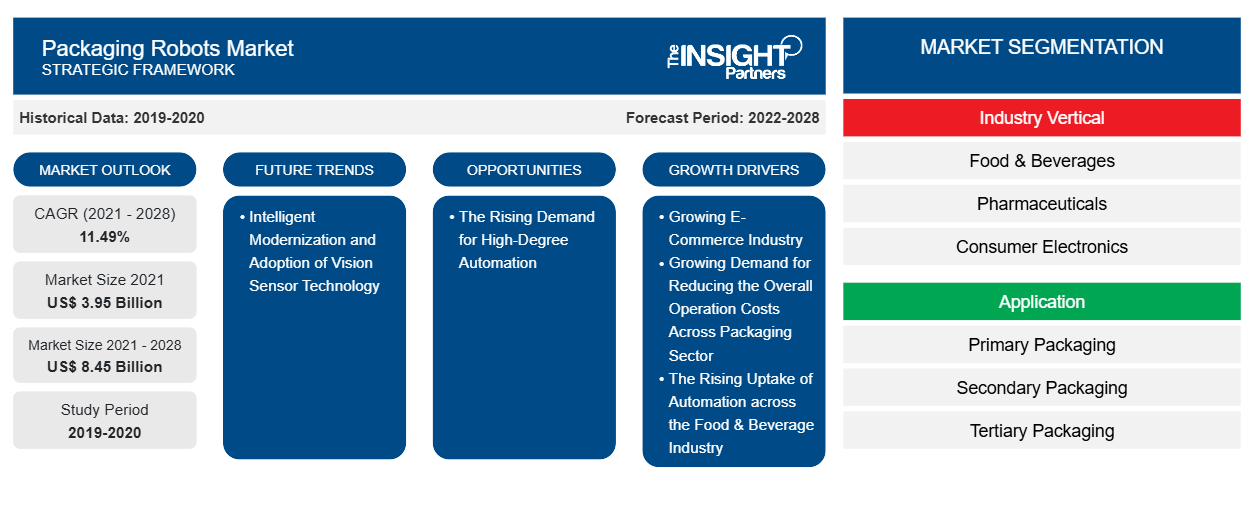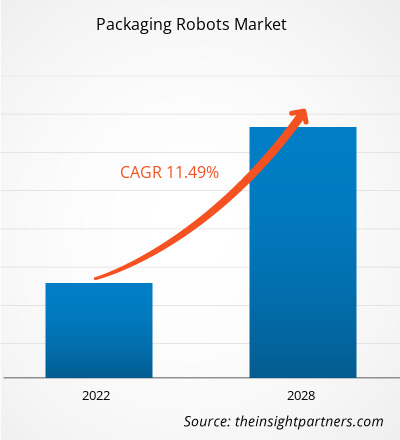[تقرير بحثي] من المتوقع أن ينمو سوق روبوتات التغليف من 3،945.43 مليون دولار أمريكي في عام 2021 إلى 8،448.21 مليون دولار أمريكي بحلول عام 2028؛ ومن المتوقع أن ينمو بمعدل نمو سنوي مركب قدره 11.49٪ خلال الفترة 2021-2028.
وجهة نظر المحلل:
توفر روبوتات التغليف الدقة والسرعة والإنتاجية لعمليات مناولة المواد، ولهذا السبب، تقوم العديد من الشركات المصنعة بتنفيذ روبوتات التغليف لتعزيز إنتاجيتها. أيضًا، نظرًا لأن روبوتات التغليف يمكنها رفع المزيد من المنتجات في وقت واحد، فإنها توفر أوقات تشغيل أعلى بكثير من العمل اليدوي وتخلق خفضًا لتكلفة العمالة في تكلفة العمالة والتشغيل الإجمالي، مما يعزز نمو سوق روبوتات التغليف . بالإضافة إلى ذلك، فإن الاستخدام المتزايد للروبوتات التعاونية لملء مئات العبوات والزجاجات وأداء مهام معقدة أخرى بكفاءة أكبر من البشر في صناعة الأغذية والمشروبات يغذي نمو سوق روبوتات التغليف. أيضًا، تعد صناعة التجارة الإلكترونية المتنامية في جميع أنحاء العالم عاملاً آخر يغذي نمو سوق روبوتات التغليف. علاوة على ذلك، من المتوقع أن يخلق الطلب المتزايد على الأتمتة عالية الدرجة فرصة لنمو سوق روبوتات التغليف في الفترة المتوقعة.
نظرة عامة على السوق:
روبوتات التغليف هي روبوتات مبرمجة للتحرك على طول مسار محدد مسبقًا من أجل التقاط الأشياء من مواقع تخزين مختلفة ووضعها على الأرفف. تعمل هذه الروبوتات بدون مساعدة من الإنسان ويمكن أن تساعد في توفير الوقت من خلال تبسيط خط إنتاجها وتقليل الحاجة إلى التدخل البشري الزائد. إنها تقدم العديد من الفوائد المهمة عبر القطاعات الصناعية المختلفة من خلال توفير السرعة والدقة والإنتاجية، وكل ذلك مع تقديم عائد سريع نسبيًا على الاستثمار (ROI) عند نشرها بشكل صحيح. اعتمادًا على أداة نهاية الذراع (EOAT)، يمكن لروبوتات التغليف إكمال العديد من المهام المختلفة. في أغلب الأحيان، تم تصميم روبوتات التغليف لفتح وتعبئة ونقل وتكديس وختم وترميز ووضع علامات على عبوات المنتجات. نظرًا للفوائد المذكورة أعلاه، فهي تُستخدم بشكل شائع في القطاعات التي يجب فيها تعبئة المنتجات بدقة وبشكل متسق وبجودة عالية لحماية سلامة المنتج. يستخدم القطاع الصناعي روبوتات التغليف بشكل كبير لتسريع أوقات الدورة وتحسين الإنتاجية، بينما تستخدم صناعة الأغذية والمشروبات روبوتات التغليف لأسباب مماثلة.
قم بتخصيص هذا التقرير ليناسب متطلباتك
ستحصل على تخصيص لأي تقرير - مجانًا - بما في ذلك أجزاء من هذا التقرير، أو تحليل على مستوى الدولة، وحزمة بيانات Excel، بالإضافة إلى الاستفادة من العروض والخصومات الرائعة للشركات الناشئة والجامعات
- احصل على أهم اتجاهات السوق الرئيسية لهذا التقرير.ستتضمن هذه العينة المجانية تحليلاً للبيانات، بدءًا من اتجاهات السوق وحتى التقديرات والتوقعات.
محركات سوق روبوتات التغليف:
إن الاستخدام المتزايد للأتمتة في صناعة الأغذية والمشروبات يدفع نمو سوق روبوتات التغليف
تشير الأتمتة في صناعة الأغذية والمشروبات إلى دمج التقنيات عبر عمليات الإنتاج المختلفة، مثل التفتيش والتعبئة والتغليف والتخزين. على مر السنين، قامت شركات الأغذية والمشروبات بتحسين عمليات الإنتاج المختلفة من خلال دمج الأنظمة الآلية، مثل المركبات الموجهة آليًا ، وروبوتات دلتا، والأذرع الروبوتية، لتتوافق مع معايير سلامة وجودة الأغذية التي وضعتها هيئات تنظيمية مختلفة وتقليل إجمالي تكلفة العمالة عبر مواقع الإنتاج.
بالإضافة إلى ذلك، تتطلب الأطعمة والمشروبات المعبأة دقة عالية وعمليات تعبئة متكررة، وهو ما يشكل تحديًا للبشر. ويؤدي هذا العامل إلى زيادة الطلب على التقنيات الروبوتية لمختلف الأنشطة، بما في ذلك التعبئة والتغليف الأولي والثانوي والتكديس على المنصات.
كما تشهد الروبوتات الموجهة بالرؤية ارتفاعًا في الطلب عبر قطاع الأغذية والمشروبات بسبب كفاءتها في إكمال المهام المتكررة المختلفة، مثل التقاط الصناديق، ومناولة الزجاجات، وتحميل الصواني. بالإضافة إلى ذلك، فإن العديد من الفوائد، بما في ذلك تحسين الكفاءة، وتعزيز إمكانية التتبع، والمرونة العالية، كانت تعزز الحاجة إلى الأتمتة في صناعة الأغذية والمشروبات. تشجع هذه العوامل منتجي الأغذية والمشروبات على زيادة استثماراتهم في تكامل التكنولوجيا الآلية عبر مرافق الإنتاج الخاصة بهم. على سبيل المثال، في عام 2021، أعلنت شركة Utz Brands Inc.، وهي علامة تجارية للوجبات الخفيفة مقرها الولايات المتحدة، عن خططها لدمج الحلول الآلية عبر مصانع الإنتاج الخاصة بها لتقليل التكلفة التشغيلية الإجمالية. وبالمثل، في عام 2022، أعلنت شركة Hormel Foods أيضًا عن خطتها لدمج الأتمتة عبر مرافق الإنتاج الخاصة بها. تعمل العلامات التجارية الأخرى للأغذية والمشروبات، مثل Tyson Foods وCargill Inc.، أيضًا على تبني التكنولوجيا الآلية. وبالتالي، فإن الاستثمار المتزايد في الأتمتة عبر صناعة الأغذية والمشروبات يغذي نمو سوق روبوتات التعبئة والتغليف.
التحليل القطاعي:
بناءً على الصناعة العمودية، يتم تقسيم سوق روبوتات التعبئة والتغليف إلى الأغذية والمشروبات والأدوية والإلكترونيات الاستهلاكية وغيرها. احتل قطاع الأغذية والمشروبات أكبر حصة سوقية في عام 2021، في حين من المتوقع أن يسجل قطاع الأدوية أعلى معدل نمو سنوي مركب خلال الفترة 2021-2028. تشهد صناعة الأغذية والمشروبات تكاملاً سريعًا لحلول الأتمتة. تمكن روبوتات التعبئة والتغليف من التغليف بشكل أسرع مع ضمان مراقبة الجودة. كما يعمل دمج روبوتات التعبئة والتغليف على تعزيز سلامة العمال، كما تعمل إمكانية التتبع من البداية إلى النهاية على زيادة الإنتاج وتقليل النفايات وتكاليف العمالة، مما يجعل الإنتاج أكثر مرونة. وبسبب هذه الفوائد، تعمل شركات الأغذية المختلفة على تحسين عملياتها باستخدام أذرع روبوتية موجهة بالرؤية ومركبات موجهة آليًا وروبوتات دلتا وأنظمة تفتيش متقدمة لضمان سلامة الأغذية ومعايير الجودة وتلبية الطلب المتزايد باستمرار. وبالتالي، فإن التبني المتزايد للأتمتة في صناعة الأغذية والمشروبات لترقية البنية التحتية الحالية يغذي نمو السوق.
التحليل الإقليمي:
من المتوقع أن تشهد منطقة آسيا والمحيط الهادئ نموًا كبيرًا في سوق روبوتات التعبئة والتغليف في الفترة المتوقعة. في المنطقة، ستحتل الصين أكبر حصة سوقية في عام 2021، في حين ستسجل الهند أعلى معدل نمو سنوي مركب خلال الفترة 2021-2028. تساعد الاستثمارات المتزايدة في الأتمتة لتحسين الإنتاجية وخفض التكاليف الشركات المصنعة على تلبية متطلبات المستهلكين المتزايدة. كما أن دمج الروبوتات يساعد في تحسين كفاءة التعبئة والتغليف ويقلل من التكاليف التشغيلية، ويتزايد الطلب عليها في مختلف القطاعات الصناعية. بالإضافة إلى ذلك، فإن الطلب على الأتمتة مدفوع بصناعة التجارة الإلكترونية المزدهرة في المنطقة. وفقًا لاتحاد النقل الجوي الدولي (IATA)، تقود منطقة آسيا والمحيط الهادئ نمو سوق التجارة الإلكترونية على مستوى العالم، حيث تمثل الصين نسبة كبيرة من النمو. وفقًا لإدارة التجارة الدولية، فإن سوق التجارة الإلكترونية في الصين هي الأكبر في العالم وتولد ما يقرب من 50٪ من معاملات العالم. وبالمثل، تشهد سوق التجارة الإلكترونية في البلدان الأخرى في منطقة آسيا والمحيط الهادئ أيضًا نموًا كبيرًا. على سبيل المثال، وفقًا لإدارة التجارة الدولية، من المتوقع أن تصل أستراليا - وهي الحادية عشرة من حيث الحجم في سوق التجارة الإلكترونية في العالم - إلى 32.3 مليار دولار أمريكي بحلول عام 2024. ووفقًا لمؤسسة حقوق العلامة التجارية الهندية (IBEF)، من المتوقع أن يصل سوق التجارة الإلكترونية في الهند إلى 188 مليار دولار أمريكي بحلول عام 2025. وبالتالي، فإن صناعة الأتمتة والتجارة الإلكترونية المتنامية تعمل على تغذية نمو السوق في منطقة آسيا والمحيط الهادئ.
تحليل اللاعب الرئيسي:
تعد ABB Ltd وBrenton Engineering وFANUC Corporation وKrones AG وKUKA Roboter GmbH وMitsubishi Electric Corporation وRemtec Automation LLC وRobert Bosch GmbH وSchnider Electric وYaskawa America من بين اللاعبين الرئيسيين في سوق روبوتات التغليف. يركز هؤلاء اللاعبون في سوق روبوتات التغليف على التطوير المستمر للمنتجات والابتكار.
رؤى إقليمية حول سوق روبوتات التغليف
لقد قام المحللون في Insight Partners بشرح الاتجاهات والعوامل الإقليمية المؤثرة على سوق روبوتات التغليف طوال فترة التوقعات بشكل شامل. يناقش هذا القسم أيضًا قطاعات سوق روبوتات التغليف والجغرافيا في جميع أنحاء أمريكا الشمالية وأوروبا ومنطقة آسيا والمحيط الهادئ والشرق الأوسط وأفريقيا وأمريكا الجنوبية والوسطى.

- احصل على البيانات الإقليمية المحددة لسوق روبوتات التعبئة والتغليف
نطاق تقرير سوق روبوتات التغليف
| سمة التقرير | تفاصيل |
|---|---|
| حجم السوق في عام 2021 | 3.95 مليار دولار أمريكي |
| حجم السوق بحلول عام 2028 | 8.45 مليار دولار أمريكي |
| معدل النمو السنوي المركب العالمي (2021 - 2028) | 11.49% |
| البيانات التاريخية | 2019-2020 |
| فترة التنبؤ | 2022-2028 |
| القطاعات المغطاة | حسب القطاع الصناعي
|
| المناطق والدول المغطاة | أمريكا الشمالية
|
| قادة السوق وملفات تعريف الشركات الرئيسية |
|
كثافة اللاعبين في سوق روبوتات التغليف: فهم تأثيرها على ديناميكيات الأعمال
يشهد سوق روبوتات التغليف نموًا سريعًا، مدفوعًا بالطلب المتزايد من المستخدم النهائي بسبب عوامل مثل تفضيلات المستهلكين المتطورة والتقدم التكنولوجي والوعي المتزايد بفوائد المنتج. ومع ارتفاع الطلب، تعمل الشركات على توسيع عروضها والابتكار لتلبية احتياجات المستهلكين والاستفادة من الاتجاهات الناشئة، مما يؤدي إلى زيادة نمو السوق.
تشير كثافة اللاعبين في السوق إلى توزيع الشركات أو المؤسسات العاملة في سوق أو صناعة معينة. وهي تشير إلى عدد المنافسين (اللاعبين في السوق) الموجودين في مساحة سوق معينة نسبة إلى حجمها أو قيمتها السوقية الإجمالية.
الشركات الرئيسية العاملة في سوق روبوتات التغليف هي:
- أي بي بي
- برينتون، ذ.م.م
- شركة فانوك
- شركة كرونيس ايه جي
- شركة كوكا ايه جي
إخلاء المسؤولية : الشركات المذكورة أعلاه ليست مرتبة بأي ترتيب معين.

- احصل على نظرة عامة على أهم اللاعبين الرئيسيين في سوق روبوتات التغليف
التطورات الأخيرة:
تتبنى الشركات في السوق بشكل كبير الاستراتيجيات غير العضوية والعضوية مثل إطلاق المنتجات والشراكات والتعاون والاندماجات والاستحواذات. وفيما يلي قائمة ببعض التطورات الرئيسية التي شهدتها السوق مؤخرًا من قبل هذه الشركات:
- في أبريل 2023، أعلنت شيمش عن إطلاق خط التعبئة والتغليف الكامل المعزز بالروبوتات TKS-C60 لمستحضرات التجميل، والذي تم تصميمه للتعامل مع عملية التعبئة والتغليف بأكملها - التغذية والملء والتغطية ووضع العلامات وتعبئة الصناديق وتكديس منتجات مستحضرات التجميل بجميع الأشكال والأحجام. يضمن TKS-C60 خط تعبئة سلسًا ومتواصلًا لمجموعة من المنتجات، من الكريمات ومستحضرات الأساس إلى العطور وطلاء الأظافر، بمعدل 60 زجاجة في الدقيقة.
- في مارس 2023، أعلنت شركة Proco Machinery، وهي شركة مصنعة لأنظمة التشغيل الآلي لصناعة التعبئة والتغليف المخصصة، عن إطلاق روبوت تعبئة جديد لمعالجة نقص العمالة المتزايد في صناعة التعبئة والتغليف. تم تصميم روبوت التعبئة الجديد من Proco للعمل جنبًا إلى جنب مع المشغلين البشريين لزيادة الكفاءة والأداء. يمكن لروبوت التعبئة الجديد أداء مجموعة من المهام، من اختبار الحاويات إلى تعبئتها في صناديق.
- في فبراير 2023، أعلنت شركة Rapid Robotics عن شراكة جديدة مع شركة Universal Robots (UR)، والتي بموجبها ستقوم الشركة الدنمركية المنتجة للروبوتات التعاونية بتزويد Rapid Robotics بأذرع روبوتية تعاونية لنشر خلايا عمل الروبوتات التعاونية في جميع أنحاء أمريكا الشمالية. كما ستمكن شركة Universal Robots شركة Rapid Robotics من خدمة عدد أكبر من العملاء والحفاظ على أوقات النشر السريعة التي يتوقعونها حتى مع استمرار Rapid Robotics في توسيع نطاقها الوطني. تتمتع هذه الروبوتات التعاونية بمجموعة واسعة من القدرات، مثل التكديس وبناء الصناديق والتعبئة، والعمليات التي تتطلب حمولة أثقل أو مدى أطول.
- في نوفمبر 2022، أعلنت OSARO، الشركة العالمية الرائدة في مجال الروبوتات التي تعمل بالذكاء الاصطناعي للتجارة الإلكترونية، عن شراكة مع SVT Robotics لتسريع دمج أنظمة الروبوتات التي تعمل على التقاط الطلبات ووضعها في التجارة الإلكترونية وشركات الخدمات اللوجستية. تتيح منصة SOFTBOT الرائدة من SVT Robotics للشركات دمج ونشر الروبوتات والأتمتة وأجهزة إنترنت الأشياء التي تحتاجها في غضون أيام أو أسابيع فقط. وكجزء من الاتفاقية، انضمت SVT Robotics إلى برنامج شركاء OSARO، والذي يوفر وصولاً شاملاً للشركات التي تتطلع إلى نشر حلول الروبوتات في عمليات التنفيذ الخاصة بها.
- في يوليو 2022، أعلنت شركة ABB أنها توسع مجموعة روبوتات FlexPicker Delta الخاصة بها باستخدام IRB 365. بفضل خمسة محاور وحمولة 1.5 كجم، فإن IRB 365 مرن وأسرع في فئته لإعادة توجيه المنتجات الخفيفة الوزن المعبأة مثل البسكويت والشوكولاتة والفلفل والحلوى والزجاجات الصغيرة والطرود. استجابةً للارتفاع في التجارة الإلكترونية والطلب المتزايد على السلع المعبأة الجاهزة للعرض، تم تطوير IRB 365 لتطبيقات تشمل الأغذية والمشروبات والأدوية والسلع الاستهلاكية، حيث تكون سرعة خط الإنتاج وقابليته للتكيف أمرًا ضروريًا.
- التحليل التاريخي (سنتان)، السنة الأساسية، التوقعات (7 سنوات) مع معدل النمو السنوي المركب
- تحليل PEST و SWOT
- حجم السوق والقيمة / الحجم - عالميًا وإقليميًا وقطريًا
- الصناعة والمنافسة
- مجموعة بيانات Excel


- Fertilizer Additives Market
- Cut Flowers Market
- Aircraft Wire and Cable Market
- Water Pipeline Leak Detection System Market
- Energy Recovery Ventilator Market
- Electronic Toll Collection System Market
- Blood Collection Devices Market
- Aircraft MRO Market
- Artwork Management Software Market
- Smart Grid Sensors Market

Report Coverage
Revenue forecast, Company Analysis, Industry landscape, Growth factors, and Trends

Segment Covered
This text is related
to segments covered.

Regional Scope
North America, Europe, Asia Pacific, Middle East & Africa, South & Central America

Country Scope
This text is related
to country scope.
الأسئلة الشائعة
The Asia Pacific packaging robots market was estimated to be the largest as well as fastest growing regions in the global packaging robots market in 2020, according to the research study. The packaging robots’ market in Asia-Pacific (APAC) is further sub-segmented into Australia, China, India, Japan, South Korea, and the Rest of Asia Pacific. The region holds the largest market share owing to well established manufacturing sector. A continuous rise in increasing disposal income across economies such as India and China are resulting in elevated consumer demand for diverse range of products. In addition, the availability of cheap laborers in the region attracts many foreign manufacturers to establish their manufacturing bases in the region. Increased investments in automation to reduce costs and improve productivity is driving the manufacturers to meet the growing consumer demands. The integration of robots improves packaging efficiency and reduces operational costs.
The food and beverage industry is witnessing rapid integration of automation solutions, including vision-guided robotic arms, packaging robots and advanced inspection systems to streamline and optimize operations. Food and beverage industry is one of the early adopters of advanced technologies. Factories in the developed nations are investing in the smart factory concept by integrating mobile devices, sensors, and connectivity devices. Before the industrial 4.0. automation in the food industry was achieved through end-of-line technologies such as computer mechanical bagging systems. One-third of processing operations employ robots, according to research by Association for Packaging and Processing Technologies..
Primary packaging is the first layer that contains the finished product and preserves it from contamination. The packaging is intended for consumers to communicate important information about the products and make it more appealing. Factor such as production parameters, product’s attributes and how products are delivered to and from the packaging equipment is crucial while considering the automation of a packaging process. Automating primary packaging through robots offers greater flexibility and provides a product to be placed in any configuration.
Packaging is a critical procedure in manufacturing facilities, especially those that produce goods for the consumer market. The installation of a robotic packaging system increases flexibility and improves the packaging line's overall production. Furthermore, packaging robots can work in a variety of temperatures and take up significantly less floor area than people. Increased demand for various items is forcing enterprises to focus on improving production efficiency and implementing better operations management. The implementation of robotic automation in packaging units can help achieve overall equipment efficiency (OEE), which is a necessary need for long-term production efficiency. Robotic installation in packaging lines improves high-speed efficiency of product selecting, packing, and palletizing by reducing physical dexterity.
Growing customer demand for high-quality goods has resulted in advancements in manufacturing technology. The food and beverage, trucking and logistics, and fast-moving consumer goods (FMCG) businesses are all focused on getting products to customers in a short amount of time, which has boosted robotic packaging use. Packaging robots has been a great potential in food and beverage industry. The deliberate integration of technology across various processes in the food and beverage industry is known as automation.
Increased demand for a variety of products from manufacturing industries like food and beverage, pharmaceutical as well as from the ecommerce industry is prompting businesses to concentrate on improving production efficiency and implementing improved operations management. Robotic automation in packaging units achieves overall equipment efficiency, which is a requirement for long-term production efficiency. Furthermore, new innovations like human-robot collaboration are further contributing in the market growth. Human-robot collaboration, in which robots and people work together closely, is referred to as collaborative robot. The robot can comprehend human commands, including speech, gestures, and so on, and begin activities accordingly.
Trends and growth analysis reports related to Electronics and Semiconductor : READ MORE..
The List of Companies - Packaging Robots Market
- ABB
- Brenton, LLC
- Fanuc Corporation
- Krones AG
- Kuka AG
- Mitsubishi Electric Corporation
- Remtec Automation, LLC
- Syntegon Technology GmbH (Bosch Packaging Technology)
- Schneider Electric SE
- Yaskawa Electric Corporation
The Insight Partners performs research in 4 major stages: Data Collection & Secondary Research, Primary Research, Data Analysis and Data Triangulation & Final Review.
- Data Collection and Secondary Research:
As a market research and consulting firm operating from a decade, we have published and advised several client across the globe. First step for any study will start with an assessment of currently available data and insights from existing reports. Further, historical and current market information is collected from Investor Presentations, Annual Reports, SEC Filings, etc., and other information related to company’s performance and market positioning are gathered from Paid Databases (Factiva, Hoovers, and Reuters) and various other publications available in public domain.
Several associations trade associates, technical forums, institutes, societies and organization are accessed to gain technical as well as market related insights through their publications such as research papers, blogs and press releases related to the studies are referred to get cues about the market. Further, white papers, journals, magazines, and other news articles published in last 3 years are scrutinized and analyzed to understand the current market trends.
- Primary Research:
The primarily interview analysis comprise of data obtained from industry participants interview and answers to survey questions gathered by in-house primary team.
For primary research, interviews are conducted with industry experts/CEOs/Marketing Managers/VPs/Subject Matter Experts from both demand and supply side to get a 360-degree view of the market. The primary team conducts several interviews based on the complexity of the markets to understand the various market trends and dynamics which makes research more credible and precise.
A typical research interview fulfils the following functions:
- Provides first-hand information on the market size, market trends, growth trends, competitive landscape, and outlook
- Validates and strengthens in-house secondary research findings
- Develops the analysis team’s expertise and market understanding
Primary research involves email interactions and telephone interviews for each market, category, segment, and sub-segment across geographies. The participants who typically take part in such a process include, but are not limited to:
- Industry participants: VPs, business development managers, market intelligence managers and national sales managers
- Outside experts: Valuation experts, research analysts and key opinion leaders specializing in the electronics and semiconductor industry.
Below is the breakup of our primary respondents by company, designation, and region:

Once we receive the confirmation from primary research sources or primary respondents, we finalize the base year market estimation and forecast the data as per the macroeconomic and microeconomic factors assessed during data collection.
- Data Analysis:
Once data is validated through both secondary as well as primary respondents, we finalize the market estimations by hypothesis formulation and factor analysis at regional and country level.
- Macro-Economic Factor Analysis:
We analyse macroeconomic indicators such the gross domestic product (GDP), increase in the demand for goods and services across industries, technological advancement, regional economic growth, governmental policies, the influence of COVID-19, PEST analysis, and other aspects. This analysis aids in setting benchmarks for various nations/regions and approximating market splits. Additionally, the general trend of the aforementioned components aid in determining the market's development possibilities.
- Country Level Data:
Various factors that are especially aligned to the country are taken into account to determine the market size for a certain area and country, including the presence of vendors, such as headquarters and offices, the country's GDP, demand patterns, and industry growth. To comprehend the market dynamics for the nation, a number of growth variables, inhibitors, application areas, and current market trends are researched. The aforementioned elements aid in determining the country's overall market's growth potential.
- Company Profile:
The “Table of Contents” is formulated by listing and analyzing more than 25 - 30 companies operating in the market ecosystem across geographies. However, we profile only 10 companies as a standard practice in our syndicate reports. These 10 companies comprise leading, emerging, and regional players. Nonetheless, our analysis is not restricted to the 10 listed companies, we also analyze other companies present in the market to develop a holistic view and understand the prevailing trends. The “Company Profiles” section in the report covers key facts, business description, products & services, financial information, SWOT analysis, and key developments. The financial information presented is extracted from the annual reports and official documents of the publicly listed companies. Upon collecting the information for the sections of respective companies, we verify them via various primary sources and then compile the data in respective company profiles. The company level information helps us in deriving the base number as well as in forecasting the market size.
- Developing Base Number:
Aggregation of sales statistics (2020-2022) and macro-economic factor, and other secondary and primary research insights are utilized to arrive at base number and related market shares for 2022. The data gaps are identified in this step and relevant market data is analyzed, collected from paid primary interviews or databases. On finalizing the base year market size, forecasts are developed on the basis of macro-economic, industry and market growth factors and company level analysis.
- Data Triangulation and Final Review:
The market findings and base year market size calculations are validated from supply as well as demand side. Demand side validations are based on macro-economic factor analysis and benchmarks for respective regions and countries. In case of supply side validations, revenues of major companies are estimated (in case not available) based on industry benchmark, approximate number of employees, product portfolio, and primary interviews revenues are gathered. Further revenue from target product/service segment is assessed to avoid overshooting of market statistics. In case of heavy deviations between supply and demand side values, all thes steps are repeated to achieve synchronization.
We follow an iterative model, wherein we share our research findings with Subject Matter Experts (SME’s) and Key Opinion Leaders (KOLs) until consensus view of the market is not formulated – this model negates any drastic deviation in the opinions of experts. Only validated and universally acceptable research findings are quoted in our reports.
We have important check points that we use to validate our research findings – which we call – data triangulation, where we validate the information, we generate from secondary sources with primary interviews and then we re-validate with our internal data bases and Subject matter experts. This comprehensive model enables us to deliver high quality, reliable data in shortest possible time.


 احصل على عينة مجانية لهذا التقرير
احصل على عينة مجانية لهذا التقرير